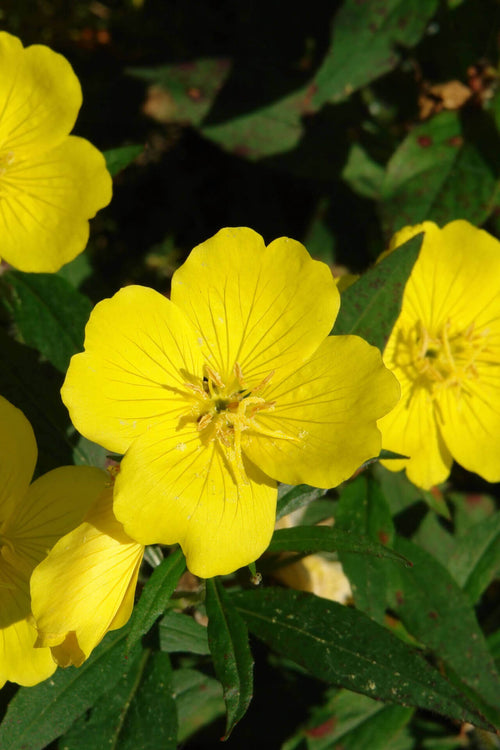Unveiling its Unusual Blooming Cycle and Exotic Sundown Display
Nature's canvas is painted with an array of breathtaking marvels, and among them, the Showy Evening Primrose (Oenothera speciosa) stands as a captivating masterpiece. This remarkable wildflower, native to North America, possesses a blooming cycle that defies convention and astonishes observers with its rare and exotic blooms that unfold exclusively at sundown. With its unique characteristics and interactions with the nocturnal world, the primrose beckons us into wonder and intrigue.
The Unusual Blooming Cycle:
A Tale of Nocturnal Elegance The Showy Evening Primrose stands apart from its floral counterparts due to its atypical blooming cycle. Unlike most flowers that open their petals with the sunrise and close them as night falls, the primrose unveils its beauty when the day transitions into night. As the sun's warm embrace recedes and the gentle twilight takes over, the primrose's buds gradually unfurl, revealing petals of delicate hues. This transformation is nothing short of a botanical ballet, a choreography set against the backdrop of the setting sun.
Exotic Blooms at Sundown:
Nature's Twilight Spectacle What sets the Showy Evening Primrose apart is its nocturnal preference and the alluring nature of its blooms. As the sun dips below the horizon, the primrose awakens from its daytime slumber, displaying an exotic and mesmerizing array of petals. These petals come to life in shades of pale pinks, creamy whites, and subtle yellows, emitting a soft and ethereal glow in the fading light. The flowers' appearance is almost otherworldly as if plucked from a dream and brought to life during this mystical time of day.
Night-Flying Pollinators: A Secret Nocturnal Tryst
The primrose's beauty is not meant solely for human admiration; it has an enchanting relationship with night-flying pollinators, further adding to its allure. While most flowers rely on diurnal insects for pollination, the Showy Evening Primrose has evolved to attract nocturnal creatures such as moths and bats. These creatures, guided by the moon and stars, venture into the darkness, driven by the delicate fragrance and faint luminosity of the primrose's blooms. This nocturnal pollination dance is a testament to the intricate connections within ecosystems, where each participant plays a role in the perpetuation of life.
The Allure of Beauty:
Primrose's Aesthetic Splendor Beauty is subjective, yet the Showy Evening Primrose possesses an intrinsic charm that captivates the hearts of all who see it. Its petals, with their graceful contours and gentle colors, embody a sense of elegance and delicacy. The fact that this beauty unfolds during the calm of twilight adds an element of exclusivity, a privilege for those who linger to witness this natural spectacle. The primrose teaches us that true beauty is not confined by convention and that something uniquely enchanting about the unconventional exists. The Showy Evening Primrose is a botanical enigma that bewitches us with its unusual blooming cycle, rare and exotic sundown display, and intricate relationship with night-flying pollinators. Its blooms at sundown defy the norms of the floral world, inviting us to witness a captivating transformation as day turns into night. The primrose's petals, delicately painted with shades of dusk, stand as a testament to nature's artistic prowess. The secret rendezvous it shares with night-flying pollinators under the moonlit sky reveals the hidden tapestry of interactions in the natural world. In its ephemeral beauty, the Showy Evening Primrose whispers a gentle reminder that there is a profound wonder even in the most unexpected corners of existence.
The Enchantment of Colors
The world of primroses is a vibrant tapestry woven with an array of captivating colors, each variety a unique expression of nature's creativity. These charming blooms come in a spectrum of hues, offering a visual feast that captures the essence of diversity in the plant kingdom. From the soft blush of delicate pink primroses to the pure and timeless elegance of snowy white varieties, the color palette of primroses is as varied as the emotions they evoke. Shades of vibrant purple and lavender add a touch of regal allure to gardens and landscapes, while sunny yellow primroses bring a cheerful warmth that can brighten even the gloomiest days. The fiery embrace of orange primrose ignites passion and energy, while cool blues and lilacs soothe the senses with their tranquil presence.
Primrose enthusiasts are treated to an ever-expanding assortment of color variations thanks to careful cultivation and hybridization. Bi-colored primroses blend two or more colors seamlessly, creating a harmonious dance of contrasts. Some varieties even boast delicate gradations within a single petal, adding a painterly quality to their appearance. These diverse colors satisfy the eye and allow gardeners and admirers to curate their visual symphony. Whether planted in solitary splendor or woven into a vibrant mosaic, primroses of varying colors can evoke emotions, set moods, and enrich outdoor spaces with their botanical charm. In a world where colors symbolize feelings and experiences, primroses stand as living embodiments of nature's ability to paint the canvas of life with an awe-inspiring palette.



















































